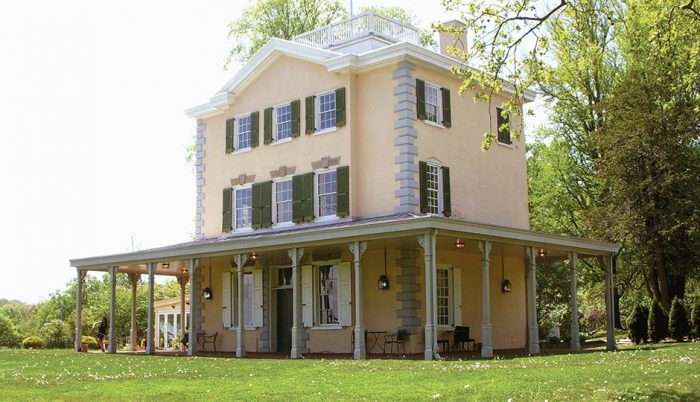Driving Tour of Fairmount Park (Philadelphia) Historic Mansions

Fairmount Park in Philadelphia is the nation’s largest urban park with a sprawling 9,200 acres of quiet, natural beauty containing miles of trails, recreational fields, shaded woodlands, and peaceful waterfront vistas all within easy reach of Philadelphia citizens. A special feature (and my personal favorite) are the many wonderfully preserved historic mansions from Philadelphia’s colonial past. Many are open for house tours but a fun and free idea is to take a driving tour past many of them. I have created a 10 mile route starting near the Philadelphia Zoo and ending at the Art Museum. My personal recommendation is to go in late spring, summer, or fall on a fair weather day for maximum effect! It only takes about an hour or less depending if you get out and take pictures. This would make a perfect pairing with the Zoo or Art Museum, depending if you bring the kids or you are spending some romantic time away as a couple.
I took this tour with a couple of girlfriends on our way to a Philadelphia race, and was able to iron out the kinks, so this should work beautifully if you follow the directions. Below the directions is a summary of each historic mansion to give you a little background information while you tour. Happy travels!

Fairmount Park Mansion Tour—Turn by Turn Directions
From Schuylkill Expy (76E)…
R on W. Girard Ave.
R Parkside Ave.
R North 41st St.
R S. Concourse Dr.
L Lansdowne Dr.
R Sweetbrier Ln
Continue straight to the dead end…
-
Sweetbrier Mansion
Back out Sweetbrier Ln.
R Cedar Grove Dr. and continue straight to the dead end…
-
Cedar Grove
Back out Cedar Grove Dr.
R Sweetbrier Ln.
L Landsdowne Dr.
Go around traffic circle and through…
-
Smith Memorial Arch
(now on Avenue of the Republic)
(Pass “Please Touch Museum” which was formerly Memorial Hall)
R Belmont Ave.
(Take note of “Ohio House” on left—Victorian mansion built for Centennial Exposition)
R Montgomery Dr.
L Belmont Mansion Dr., then bear Left
-
Belmont Mansion
and Plateau (good city skyline views!)
Continue on Belmont Mansion Dr.
R S.Chamounix Dr.
Bear R Chamounix Dr.
R W. Ford Rd.
R Greenland Dr.
Cross over bridge, (called Strawberry Mansion Bridge)
Stay straight, now called Woodford Dr.
L Woodford Ln
L Greenland Dr.
-
Historic Strawberry Mansion
Go back where you came from and continue straight which turns into Greenland Dr. and on the right is…
-
Woodford Mansion
Continue on Greenland Dr.
R W. Dauphin Dr.
L E. Reservoir Dr.
R Edgely Dr.
-
Laurel Hill Mansion
(on left)
Continue along Edgely Dr.
R E. Reservoir Dr.
-
Ormiston Mansion (on Right)
R Mount Pleasant Dr.
-
Mount Pleasant Mansion
Continue on Mt. Pleasant Dr. and on left is…
-
Rockland Mansion
Continue on Mt. Pleasant Dr.
R E. Reservoir Dr.
R Fountain Green Dr.
L Kelly Drive (hidden behind trees is the Smith Memorial Playground—look it up, a wonderful place for kids!)
Drive for a little while until you spot the beginning of Boathouse Row
L (second entrance maybe) onto Lemon Hill Dr.
Bear R, follow until on Left is…
-
Lemon Hill Mansion
R Sedgley Dr.
L Kelly Dr.
R around Eakins Oval (past Rocky Statue in front of the Art Museum)

(Google the names for more information and touring hours. Many are open by appointment only.)
Sweetbriar (1797) Neoclassical mansion in the Federal style. The mansion was built by Samuel Breck and named for the roses that grew on the property. The interior includes a double parlor and floor-to-ceiling windows with sweeping views of the Schuylkill River. Breck was a child during the American Revolution but lived to see the Union closing in on victory in the Civil War and it pained him greatly to see the country that he loved coming apart from within. At the age of 90, he famously said “I was a man when (the United States) were formed, and God forbid that I should live to witness their downfall!”
Cedar Grove (1750) was originally located in northeast Philadelphia, starting with a simple home and over the years additions made it more elaborate. Five generations of the Morris family lived in the farmhouse from 1793 to 1926 when a railroad was built near the house and made it undesirable to live in. The family paid to have it disassembled and rebuilt in Fairmount Park as a house museum. Fine-quality woodwork and a unique double-dogleg staircase are notable details of this Philadelphia Quaker farmhouse. Cedar Grove is special because most of the objects and furnishings are original to the house and represent a 200 year accumulation of the family’s belongings.
Smith Memorial Arch is an American Civil War monument. Built on the former grounds of the 1876 Centennial Exposition, it serves as a grand gateway to West Fairmount Park. The Memorial consists of two colossal columns supported by curving, neo-Baroque arches, and adorned with 13 individual portrait sculptures (2 equestrians, 3 figures, and 8 busts); two eagles standing on globes; and architectural reliefs of 8 allegorical figures.
Belmont Mansion (1743) the mansion is one of the finest examples of Palladian architecture in the United States. William Peters, an English lawyer and land management agent for the Penn family, built Belmont and planted formal gardens around it. As the American Revolution approached, William who was a Loyalist returned to England and the estate passed to William’s son, Richard Peters, Jr., who had been born there. Richard served as Speaker of the Pennsylvania Assembly, Pennsylvania State Senator and Judge of the United States District Court. An amateur scientist, he operated the estate farm as a working model of scientific agriculture.
Many prominent figures in the Revolution stayed at the mansion including George Washington (a close friend of Judge Peters), John Adams, Thomas Jefferson, and James Madison. Peters was an abolitionist and the mansion became a stop on the Underground Railroad. Belmont currently houses an Underground Railroad Museum and also hosts special events including outdoor weddings. On a clear day, the front lawn has a spectacular view of the Philadelphia skyline. This mansion is my favorite because William Peters is in my family tree!
Historic Strawberry Mansion (1789) is a summer home originally built for Judge William Lewis. As a lawyer during revolutionary times, he consistently defended other Quakers against charges of treason after they refused to fight in battle or pay taxes. In doing so he participated in creating the foundations of Conscientious Objection. Lewis was appointed to Federal Judicial positions by George Washington and also advised Alexander Hamilton on the first national bank. His most important achievement was his role in the drafting and passage of An Act for the Gradual Abolition of Slavery in 1780. This legislation was the first legal action towards the abolition of slavery in the United States of America. Originally named “Summerville,” the mansion later became known as the Strawberry Mansion as ice cream and strawberries were served here when it was a restaurant for day trippers in Fairmount Park.
Woodford (1756) is the first of the great, opulent, late-Georgian mansions to be erected in the Philadelphia area. Originally a 1½-story summer residence for William Coleman, a wealthy merchant and justice of the Pennsylvania Supreme Court, the mansion exchanged owners several times and eventually a second floor addition was added.
The building was restored in 1927, and opened to the public as a house museum, which it remains today, showcasing a collection of American decorative arts from the Naomi Wood Trust and accurately portraying 18th century decorating.
Laurel Hill (1767) Rebecca Rawle, a wealthy widow with three young children built this small country house. Her second marriage was to the British Loyalist and former Mayor of Philadelphia Samuel Shoemaker. Her home was seized during the Revolution, and the years that followed were difficult for Rebecca and her family. Rebecca spent several years trying to reclaim her house, which was sold in 1782 to Major James Parr. She was able to buy back Laurel Hill and pay off some debts in part by using some of the profits on the produce raised at the home, including strawberries, cabbages and vegetables. Two building additions increased the size of this home, can you tell what the original house looked like?
Ormistan (1798) erected by Edward Burd. It is not furnished or open to the public.
Rockland (1810) built by dry goods merchant George Thomson. Unusual during the Federal period is the semi-circular projection with columns over the front door. It is also not open to the public and now houses the Psychoanalytic Center of Philadelphia.
Mount Pleasant (1761) was built in what was then the countryside outside the city by John Macpherson and his wife Margaret. Macpherson was a privateer in the French and Indian War, or perhaps a pirate, who had had “an arm twice shot off” according to John Adams. The builder-architect was Thomas Nevell, an apprentice of Edmund Woolley, who built Independence Hall. The mansion is the best surviving example of a Middle-Georgian country house of the 1760’s. Notice the precise symmetry of the architecture! It was declared a National Historic Landmark in 1974. Two small symmetrical pavilions flank the main house, an office and a summer kitchen. John Adams visited the mansion in 1775 and called it “the most elegant seat in Pennsylvania.” The interiors contain the original paneling with ornamental carving, and still show the “elegance of the lifestyle of colonial elites,” as well as souvenirs of Macpherson’s life and times. Mount Pleasant was also home to Benedict Arnold (the general accused of treason in the Revolutionary War) who purchased the mansion in 1779 but due to the high price of the estate and Benedict’s deteriorating funds, he had to sell it, thus never got a chance to move in.
Lemon Hill (1800) is a Federal-style mansion built by the merchant Henry Pratt. Originally part of Robert Morris’s 300-acre estate, the mansion is named for the many lemon trees in Morris’s greenhouse, which was part of his new property. Pratt lived here until his death in 1838.
Lemon Hill is located on a bluff overlooking the Schuylkill River and Boathouse Row. Exceptional architectural features include its three oval parlors, stacked one on top of the other, with curved fireplace mantles and doors.
The mansion was restored by the architectural historian Fiske Kimball in 1925, who lived here while president of the Philadelphia Museum of Art, 1925–55.
(some excerpts taken from Wikipedia)




